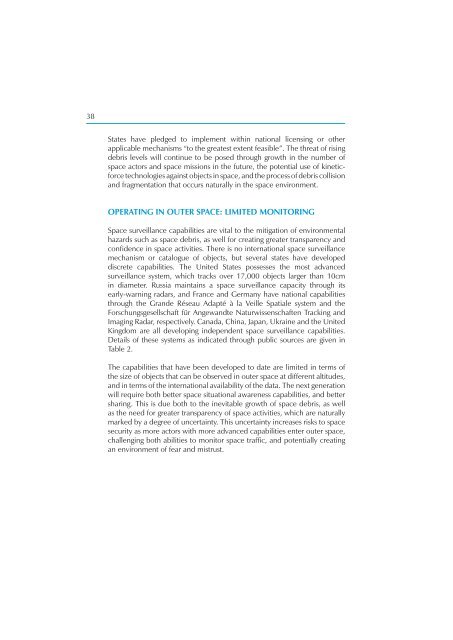Security in Space The Next Generation - UNIDIR
Security in Space The Next Generation - UNIDIR
Security in Space The Next Generation - UNIDIR
You also want an ePaper? Increase the reach of your titles
YUMPU automatically turns print PDFs into web optimized ePapers that Google loves.
38<br />
States have pledged to implement with<strong>in</strong> national licens<strong>in</strong>g or other<br />
applicable mechanisms “to the greatest extent feasible”. <strong>The</strong> threat of ris<strong>in</strong>g<br />
debris levels will cont<strong>in</strong>ue to be posed through growth <strong>in</strong> the number of<br />
space actors and space missions <strong>in</strong> the future, the potential use of k<strong>in</strong>eticforce<br />
technologies aga<strong>in</strong>st objects <strong>in</strong> space, and the process of debris collision<br />
and fragmentation that occurs naturally <strong>in</strong> the space environment.<br />
OPERATING IN OUTER SPACE: LIMITED MONITORING<br />
<strong>Space</strong> surveillance capabilities are vital to the mitigation of environmental<br />
hazards such as space debris, as well for creat<strong>in</strong>g greater transparency and<br />
confi dence <strong>in</strong> space activities. <strong>The</strong>re is no <strong>in</strong>ternational space surveillance<br />
mechanism or catalogue of objects, but several states have developed<br />
discrete capabilities. <strong>The</strong> United States possesses the most advanced<br />
surveillance system, which tracks over 17,000 objects larger than 10cm<br />
<strong>in</strong> diameter. Russia ma<strong>in</strong>ta<strong>in</strong>s a space surveillance capacity through its<br />
early-warn<strong>in</strong>g radars, and France and Germany have national capabilities<br />
through the Grande Réseau Adapté à la Veille Spatiale system and the<br />
Forschungsgesellschaft für Angewandte Naturwissenschaften Track<strong>in</strong>g and<br />
Imag<strong>in</strong>g Radar, respectively. Canada, Ch<strong>in</strong>a, Japan, Ukra<strong>in</strong>e and the United<br />
K<strong>in</strong>gdom are all develop<strong>in</strong>g <strong>in</strong>dependent space surveillance capabilities.<br />
Details of these systems as <strong>in</strong>dicated through public sources are given <strong>in</strong><br />
Table 2.<br />
<strong>The</strong> capabilities that have been developed to date are limited <strong>in</strong> terms of<br />
the size of objects that can be observed <strong>in</strong> outer space at different altitudes,<br />
and <strong>in</strong> terms of the <strong>in</strong>ternational availability of the data. <strong>The</strong> next generation<br />
will require both better space situational awareness capabilities, and better<br />
shar<strong>in</strong>g. This is due both to the <strong>in</strong>evitable growth of space debris, as well<br />
as the need for greater transparency of space activities, which are naturally<br />
marked by a degree of uncerta<strong>in</strong>ty. This uncerta<strong>in</strong>ty <strong>in</strong>creases risks to space<br />
security as more actors with more advanced capabilities enter outer space,<br />
challeng<strong>in</strong>g both abilities to monitor space traffi c, and potentially creat<strong>in</strong>g<br />
an environment of fear and mistrust.








